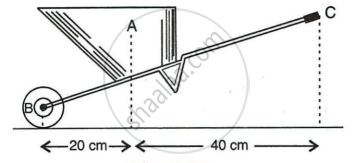Advertisements
Advertisements
प्रश्न
- State the relationship between mechanical advantage, velocity ratio and efficiency.
- Name the term that will not change for a machine of a given design.
उत्तर
Relation between M.A., V.R. and η
i. Efficiency = `"Work output"/"Work input"`
= `(L xx d_L)/(E xx d_E)`
= `(L/E)/((dE)/(dL))`
But `L/E` = M.A. and `(dE)/(dL)` = V.R.
Efficiency = η = `(M.A)/ (V.R.)` or M.A. = η × V.R.
ii. For a machine of a certain design, the term velocity ratio remains constant since M.A. = V.R.
APPEARS IN
संबंधित प्रश्न
Explain the term mechanical advantage.
Define the term velocity ratio.
How is the mechanical advantage related with the velocity ratio for an actual machine? State whether the efficiency of such a machine is equal to 1, less than 1 or more than 1.
Draw diagrams to illustrate the position of fulcrum load and effort, in the following:
A seesaw
Draw a diagram to illustrate the position of fulcrum load and effort, in the following:
A common balance
Draw a diagram to illustrate the position of fulcrum load and effort, in the following:
Forceps
Figure below shows a wheel barrow of mass 15 kgf carrying a load of 30 kgf with its centre of gravity at A. The points B and C are the centre of wheel and tip of the handle such that the horizontal distance AB = 20 cm and AC = 40 cm.

Find:
- the load arm,
- the effort arm,
- the mechanical advantage and
- the minimum effort required to keep the leg just off the ground.
A fire tongs has arms 20 cm long. It is used to lift a coal of weight 1.5 kgf by applying an effort at a distance 15 cm from the fulcrum. Find:
- the mechanical advantage of fire tongs and
- the effort needed.
In class II lever, effort arm is ______ than the load arm.
Mechanical advantage = ______ × velocity ratio.
